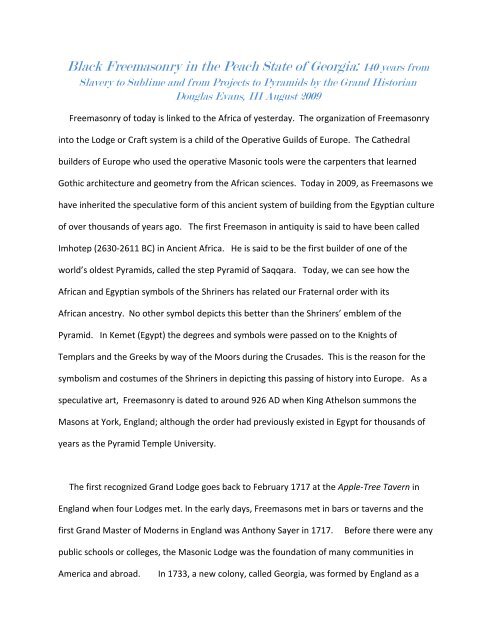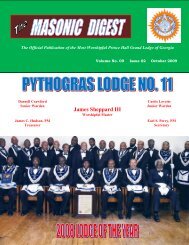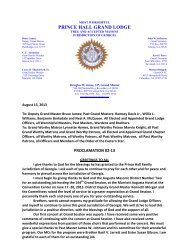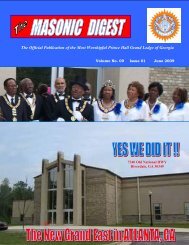Black Freemasonry in the Peach State of Georgia - Prince Hall ...
Black Freemasonry in the Peach State of Georgia - Prince Hall ...
Black Freemasonry in the Peach State of Georgia - Prince Hall ...
Create successful ePaper yourself
Turn your PDF publications into a flip-book with our unique Google optimized e-Paper software.
<strong>Black</strong> <strong>Freemasonry</strong> <strong>in</strong> <strong>the</strong> <strong>Peach</strong> <strong>State</strong> <strong>of</strong> <strong>Georgia</strong>: 140 years fromSlavery to Sublime and from Projects to Pyramids by <strong>the</strong> Grand HistorianDouglas Evans, III August 2009<strong>Freemasonry</strong> <strong>of</strong> today is l<strong>in</strong>ked to <strong>the</strong> Africa <strong>of</strong> yesterday. The organization <strong>of</strong> <strong>Freemasonry</strong><strong>in</strong>to <strong>the</strong> Lodge or Craft system is a child <strong>of</strong> <strong>the</strong> Operative Guilds <strong>of</strong> Europe. The Ca<strong>the</strong>dralbuilders <strong>of</strong> Europe who used <strong>the</strong> operative Masonic tools were <strong>the</strong> carpenters that learnedGothic architecture and geometry from <strong>the</strong> African sciences. Today <strong>in</strong> 2009, as Freemasons wehave <strong>in</strong>herited <strong>the</strong> speculative form <strong>of</strong> this ancient system <strong>of</strong> build<strong>in</strong>g from <strong>the</strong> Egyptian culture<strong>of</strong> over thousands <strong>of</strong> years ago. The first Freemason <strong>in</strong> antiquity is said to have been calledImhotep (2630‐2611 BC) <strong>in</strong> Ancient Africa. He is said to be <strong>the</strong> first builder <strong>of</strong> one <strong>of</strong> <strong>the</strong>world’s oldest Pyramids, called <strong>the</strong> step Pyramid <strong>of</strong> Saqqara. Today, we can see how <strong>the</strong>African and Egyptian symbols <strong>of</strong> <strong>the</strong> Shr<strong>in</strong>ers has related our Fraternal order with itsAfrican ancestry. No o<strong>the</strong>r symbol depicts this better than <strong>the</strong> Shr<strong>in</strong>ers’ emblem <strong>of</strong> <strong>the</strong>Pyramid. In Kemet (Egypt) <strong>the</strong> degrees and symbols were passed on to <strong>the</strong> Knights <strong>of</strong>Templars and <strong>the</strong> Greeks by way <strong>of</strong> <strong>the</strong> Moors dur<strong>in</strong>g <strong>the</strong> Crusades. This is <strong>the</strong> reason for <strong>the</strong>symbolism and costumes <strong>of</strong> <strong>the</strong> Shr<strong>in</strong>ers <strong>in</strong> depict<strong>in</strong>g this pass<strong>in</strong>g <strong>of</strong> history <strong>in</strong>to Europe. As aspeculative art, <strong>Freemasonry</strong> is dated to around 926 AD when K<strong>in</strong>g A<strong>the</strong>lson summons <strong>the</strong>Masons at York, England; although <strong>the</strong> order had previously existed <strong>in</strong> Egypt for thousands <strong>of</strong>years as <strong>the</strong> Pyramid Temple University.The first recognized Grand Lodge goes back to February 1717 at <strong>the</strong> Apple‐Tree Tavern <strong>in</strong>England when four Lodges met. In <strong>the</strong> early days, Freemasons met <strong>in</strong> bars or taverns and <strong>the</strong>first Grand Master <strong>of</strong> Moderns <strong>in</strong> England was Anthony Sayer <strong>in</strong> 1717.Before <strong>the</strong>re were anypublic schools or colleges, <strong>the</strong> Masonic Lodge was <strong>the</strong> foundation <strong>of</strong> many communities <strong>in</strong>America and abroad.In 1733, a new colony, called <strong>Georgia</strong>, was formed by England as a
uffer to <strong>the</strong> Spanish <strong>in</strong> Florida and as a refuge for <strong>the</strong> debtors and crim<strong>in</strong>als <strong>of</strong> England.Itmust also be noted that <strong>in</strong> December <strong>of</strong> 1733 at a sermon <strong>of</strong> <strong>the</strong> Grand Lodge <strong>of</strong> England at <strong>the</strong>Devil’s Tavern <strong>in</strong> London, a plan was devised for all <strong>the</strong> Masonic Brethren to have <strong>the</strong>opportunity to erase <strong>the</strong>ir debts by cultivat<strong>in</strong>g <strong>the</strong> land <strong>of</strong> <strong>the</strong> new colony <strong>of</strong> <strong>Georgia</strong>. GeneralOglethorpe along with o<strong>the</strong>r English Masons sailed on <strong>the</strong> Good Ship “Anne” and landed at <strong>the</strong>Yamacraw Bluff on February 12, 1733. Therefore, it can be said that <strong>the</strong> <strong>State</strong> <strong>of</strong> <strong>Georgia</strong> was aMasonic <strong>in</strong>vention.Keep <strong>in</strong> m<strong>in</strong>d that at this time, <strong>the</strong>re was no United <strong>State</strong>s, no Constitution, noIndependence declared, no cars, or paved streets. No one knew for sure <strong>the</strong> true orig<strong>in</strong>s <strong>of</strong><strong>Freemasonry</strong> at this time, but <strong>the</strong> first use <strong>of</strong> <strong>the</strong> term was <strong>in</strong> 1356 as a Code <strong>of</strong> MasonicRegulations <strong>in</strong> London, England. Before that we f<strong>in</strong>d <strong>the</strong> term <strong>in</strong> Africa as phre for sons andmesons for light or “Sons <strong>of</strong> light”. In 1390 we have <strong>the</strong> Regius Manuscripts as <strong>the</strong> first extantMasonic document about <strong>Freemasonry</strong>. It was written <strong>in</strong> Middle English. The earliest evidence<strong>of</strong> a Lodge record was <strong>in</strong> Scotland at Aitchison’s Haven <strong>in</strong> 1598. The m<strong>in</strong>utes <strong>of</strong> Mary’s ChapelLodge at Ed<strong>in</strong>burgh record <strong>the</strong> first Masonic activity <strong>in</strong> <strong>the</strong> Old World.We know that <strong>the</strong> first Freemason to enter <strong>the</strong> American Colonies was John Skene <strong>in</strong>October 1682, a member <strong>of</strong> Aberdeen Lodge #1 <strong>of</strong> Scotland. He settled <strong>in</strong> Burl<strong>in</strong>gton, NewJersey. In 1704, <strong>the</strong> first American to be made a Mason was Jonathan Belcher <strong>of</strong> AberdeenLodge #1. The first Masonic Lodge meet<strong>in</strong>g to take place <strong>in</strong> North America was St. John’s Lodge<strong>in</strong> Philadelphia, PA dat<strong>in</strong>g back to 1731. The first Prov<strong>in</strong>cial Grand Master <strong>in</strong> North Americawas Daniel Coxe. On June 1, 1730, Daniel Coxe was appo<strong>in</strong>ted by <strong>the</strong> Duke <strong>of</strong> Norfolk as <strong>the</strong>Masonic Governor for Massachusetts, Pennsylvania, New Jersey, and New York.
Simultaneously, <strong>the</strong> first Masonic Lodge <strong>in</strong> <strong>Georgia</strong> was accredited to General James EdwardOglethorpe on February 12, 1733 when he and several o<strong>the</strong>r Freemasons landed on <strong>the</strong> shores<strong>of</strong> Savannah. Just shortly afterwards on April 13, <strong>the</strong> first Grand Lodge (Caucasian) <strong>in</strong> <strong>the</strong>Americas was formed by Henry Price <strong>in</strong> Boston, MA. On February 10, 1734, <strong>the</strong> order came to<strong>Georgia</strong> <strong>of</strong>ficially when <strong>the</strong> Grand Master <strong>of</strong> Masons <strong>of</strong> England and Lord Viscount <strong>of</strong>Weymouth, Thomas Tynne issued a warrant to Roger Lacey, Esquire <strong>of</strong> Savannah. This Lodge(for Caucasians) was chartered and later known as K<strong>in</strong>g Solomon’s Lodge became <strong>the</strong> first <strong>in</strong><strong>Georgia</strong>. The Grand Lodge <strong>of</strong> <strong>Georgia</strong> was later organized <strong>in</strong> 1786 with Solomon’s Lodge #1 andHiram Lodge #2. The first Grand Master <strong>of</strong> Masons <strong>in</strong> <strong>Georgia</strong> was William Stephens from1787‐1788.<strong>Freemasonry</strong> did not enter Atlanta <strong>in</strong> <strong>the</strong> White community until April 13, 1847 when AtlantaLodge #59 was chartered. The Lodge met on <strong>the</strong> corner <strong>of</strong> Lloyd (now Central Avenue) andAlabama Street. The first Worshipful Master was Leonard Christian Simpson. The first WhiteLodge chartered <strong>in</strong> Fulton County was Fulton Lodge #216 on October 30, 1857. They met on<strong>Peach</strong>tree and Ca<strong>in</strong> Streets at <strong>the</strong> Masonic Temple where this beautiful edifice still standstoday. This is around <strong>the</strong> time that many <strong>Black</strong>s moved to <strong>the</strong> Atlanta area.Pr<strong>in</strong>ce <strong>Hall</strong> and our Beg<strong>in</strong>n<strong>in</strong>gFor men <strong>of</strong> African American descent, <strong>Freemasonry</strong> did not beg<strong>in</strong> until 1775, when Pr<strong>in</strong>ce<strong>Hall</strong> and fourteen <strong>of</strong> his companions were <strong>in</strong>itiated <strong>in</strong>to Army Lodge #441. The hallmark <strong>of</strong><strong>Freemasonry</strong> and Fraternal life for <strong>Black</strong> men <strong>in</strong> <strong>the</strong> shores <strong>of</strong> America started <strong>in</strong> 1775 before<strong>the</strong> nation was even founded <strong>in</strong> 1776. Pr<strong>in</strong>ce <strong>Hall</strong> and 14 o<strong>the</strong>r black men were <strong>in</strong>itiated <strong>in</strong>toArmy Lodge #441 which was attached to a British Infantry regiment and chartered by <strong>the</strong> Grand
Respectively; over 100 years after Pr<strong>in</strong>ce <strong>Hall</strong> <strong>Freemasonry</strong>.If we exam<strong>in</strong>e this time period <strong>in</strong> <strong>the</strong> South, dur<strong>in</strong>g <strong>the</strong> Civil War, a <strong>Black</strong> man sought refugefrom <strong>the</strong> war by leav<strong>in</strong>g his home town <strong>of</strong> Savannah and sail<strong>in</strong>g to Boston, MA. James M.Simms, while <strong>in</strong> Boston, became a Baptist M<strong>in</strong>ister as well as a Freemason. Keep <strong>in</strong> m<strong>in</strong>d thatSlavery had been <strong>in</strong> <strong>the</strong> state s<strong>in</strong>ce 1750, though when <strong>the</strong> Colony <strong>of</strong> <strong>Georgia</strong> was charteredSlavery was not permitted <strong>in</strong> <strong>the</strong> territory. <strong>Freemasonry</strong> <strong>in</strong> <strong>the</strong> South, at this time, had manyobstacles <strong>in</strong> its development. With authority from <strong>the</strong> African Grand Lodge <strong>of</strong> Massachusetts, asa prov<strong>in</strong>cial Grand Master for Florida, <strong>Georgia</strong>, and Alabama, Rev. Simms chartered <strong>the</strong> firstMasonic Lodge <strong>in</strong> <strong>Georgia</strong> for men <strong>of</strong> African American descent on February 4, 1866 withEureka Lodge #11. This lodge was chartered by <strong>the</strong> National Compact Grand Lodge <strong>of</strong>Massachusetts. Simms chartered John T. Hilton Lodge #13 on September <strong>of</strong> 1866 <strong>in</strong> Savannah,also chartered by <strong>the</strong> Grand Lodge <strong>of</strong> Massachusetts. On December 6, 1866, <strong>the</strong> third Lodge forAfrican Americans was chartered <strong>in</strong> Augusta, GA as Bannekar Lodge #38, which was charteredby <strong>the</strong> Grand Lodge <strong>of</strong> Pennsylvania. On August 22, 1870 Rev. James Simms helps to organize<strong>the</strong> Grand Lodge <strong>of</strong> <strong>Georgia</strong> (for <strong>Black</strong>s) with Eureka #1, Hilton #2, and Bannekar #3. The list <strong>of</strong>Grand Masters <strong>in</strong> <strong>Georgia</strong> for <strong>the</strong> Most Worshipful Pr<strong>in</strong>ce <strong>Hall</strong> Grand Masters <strong>of</strong> <strong>the</strong> GrandLodge <strong>of</strong> <strong>Georgia</strong>:1870‐1872 Rev. James M. Simms1872‐1874 Louis B. Toomer1874‐1883 John H. DeVeaux1883‐1886 Alexander Harris1886‐1888 Anthony K. Desverney1888‐1889 William E. Terry1889‐1894 John D. Campbell
1894‐1901 William E. Terry1901‐1931 Dr. Henry Ru<strong>the</strong>rford Butler1931‐1961 John Wesley Dobbs1961‐1991 Dr. X. L. Neal1991‐1995 Neal A. McQueen1995‐2000 Benjam<strong>in</strong> P. Barksdale2000‐2005 Willie L. Williams2005‐present Ramsey Davis, Jr.In 2009, our Grand Master, Ramsey Davis Jr. has prepared us well for <strong>the</strong> 21 st Century. Wehave purchased <strong>in</strong> <strong>the</strong> last couple <strong>of</strong> years, a new multi‐million dollar build<strong>in</strong>g <strong>in</strong> Fulton County,<strong>Georgia</strong>, to serve as our headquarters. Grand Master Davis also purchased our older build<strong>in</strong>gfrom <strong>the</strong> 5 orig<strong>in</strong>al Lodge owners <strong>in</strong> 2006, and today it serves as a meet<strong>in</strong>g place for many <strong>of</strong>our Lodges with<strong>in</strong> <strong>the</strong> Atlanta Masonic District. This older build<strong>in</strong>g on 330 Auburn Avenue wascompleted <strong>in</strong> 1940, by Grand Master John Wesley Dobbs.The Leadership with<strong>in</strong> <strong>the</strong> Pr<strong>in</strong>ce <strong>Hall</strong> family <strong>of</strong> <strong>Georgia</strong> has been among <strong>the</strong> “Who’s Who” or<strong>the</strong> best <strong>of</strong> our society. The first Grand Master and pioneer <strong>in</strong> <strong>Georgia</strong> was James MerilousSimms. Simms was well known <strong>in</strong> <strong>the</strong> Baptist Church as well as <strong>in</strong>strumental <strong>in</strong> conduct<strong>in</strong>g asecret school for <strong>Black</strong>s prior to <strong>the</strong> Civil War. He was given 39 lashes <strong>in</strong> a public beat<strong>in</strong>g forbe<strong>in</strong>g caught teach<strong>in</strong>g young blacks how to read and write. Our first Grand Master who servedfor 2 years was an orator, politician, writer, and fraternal organizer. He was also an ArmyChapla<strong>in</strong> and was elected to serve one term <strong>in</strong> <strong>the</strong> <strong>Georgia</strong> House <strong>of</strong> Representatives forChatham County. In 1867, Simms helped publish a newspaper called <strong>the</strong> Sou<strong>the</strong>rn Radical, <strong>the</strong>first periodical published by a <strong>Black</strong> person <strong>in</strong> Savannah. Simms was also a Judge and first
Proctor <strong>of</strong> Savannah <strong>State</strong> College. In 1888 he authored, The First Colored Baptist Church <strong>of</strong>North America.Our 2 nd Grand Master was Louis B. Toomer. Grand Master Toomer was one<strong>of</strong> three Masonic founders for <strong>the</strong> <strong>Black</strong> newspaper, The Savannah Tribune. This paper is still <strong>in</strong>pr<strong>in</strong>t. Bro. Toomer served <strong>the</strong> Grand Lodge for two years and was also one <strong>of</strong> <strong>the</strong> founders <strong>of</strong><strong>the</strong> Republican Party <strong>in</strong> <strong>Georgia</strong>. The 3 rd Grand Master <strong>of</strong> Masons <strong>in</strong> <strong>Georgia</strong>, John DeVeaux,was also one <strong>of</strong> <strong>the</strong> founders <strong>of</strong> <strong>the</strong> Savannah Tribune. DeVeaux was also one <strong>of</strong> <strong>the</strong> organizersfor <strong>the</strong> Republican Party and was also one <strong>of</strong> <strong>the</strong> founders <strong>of</strong> <strong>the</strong> Wage Earners Bank. GrandMaster DeVeaux was commissioned by <strong>the</strong> Governor <strong>of</strong> <strong>Georgia</strong> as a lifetime Colonel. Heserved as Grand Master for 9 years and assisted James Simms and Louis Toomer with <strong>the</strong>formation <strong>of</strong> <strong>the</strong> Grand Lodge <strong>of</strong> <strong>Georgia</strong> on August 22, 1870 <strong>in</strong> Savannah. In 1889, he leftSavannah to become <strong>the</strong> Assistant Collector <strong>of</strong> Customs for <strong>the</strong> Savannah Port at Brunswick.The next Grand Master <strong>of</strong> <strong>Georgia</strong> was Alexander Harris, a well known m<strong>in</strong>ister from Savannah.Rev. Harris served for 3 years. The next Grand Master, Anthony Desverney also served for 2years. Desverney like his predecessors was also a military man. He became Capta<strong>in</strong> and aCommander <strong>of</strong> <strong>the</strong> Colquet Blues Infantry Unit. He had a seat on <strong>the</strong> Savannah CottonExchange, and when he died it was said that Desverney was <strong>the</strong> wealthiest Negro <strong>in</strong> ChathamCounty.It is an <strong>in</strong>terest<strong>in</strong>g fact that most <strong>of</strong> <strong>the</strong> Grand Masters that formed <strong>the</strong> Grand Lodge <strong>of</strong><strong>Georgia</strong> for <strong>Black</strong> men were all connected to <strong>the</strong> <strong>Black</strong> Church as well as <strong>the</strong> U.S. Military. Theywere all accomplished and <strong>in</strong> many cases very successful bus<strong>in</strong>essmen. Most <strong>of</strong> our orig<strong>in</strong>alfounders have grave sites <strong>in</strong> <strong>the</strong> City <strong>of</strong> Savannah at <strong>the</strong> historic Laurel Grove Cemetery. It islocated as <strong>the</strong> South Cemetery on B. Street <strong>of</strong>f <strong>of</strong> Ma<strong>in</strong> Street. These men are our foundersthat sacrificed so much to br<strong>in</strong>g <strong>the</strong> Fraternity to <strong>the</strong> African American community at a time
when <strong>the</strong>re was no “Civil Rights movement,” no cell phones or emails to fur<strong>the</strong>r <strong>the</strong>ir cause;only dedication.In 1901, <strong>in</strong> <strong>the</strong> 20 th Century <strong>Freemasonry</strong> came to <strong>the</strong> <strong>Black</strong> Community from Savannah toAtlanta with <strong>the</strong> election <strong>of</strong> Dr. H. R. Butler. Henry Ru<strong>the</strong>rford Butler was <strong>the</strong> first GrandMaster <strong>of</strong> Masons from outside <strong>the</strong> Savannah area. He was one <strong>of</strong> <strong>the</strong> first African American’sto practice medic<strong>in</strong>e <strong>in</strong> <strong>the</strong> Atlanta area. He was <strong>the</strong> first black person to write an article for<strong>the</strong> Atlanta Journal and Constitution, called “What <strong>the</strong> Colored people are Do<strong>in</strong>g.”Perhapsnone <strong>of</strong> <strong>the</strong> Pr<strong>in</strong>ce <strong>Hall</strong> leaders are as well known as <strong>the</strong> 10 th Grand Master for <strong>Georgia</strong>, JohnWesley Dobbs. Grand Master Dobbs was a legendary almost mythical figure. Dr. Butler beforehim had made plans for a Masonic Temple <strong>in</strong> Atlanta, but it was Dobbs who brought that visionto reality. Dobbs took over <strong>the</strong> order <strong>in</strong> 1931 and was faced with many obstacles such as <strong>the</strong>Great Depression. The economic ills <strong>of</strong> <strong>the</strong> Depression took our membership <strong>in</strong> <strong>Georgia</strong> from24,000 to 2,500. Even <strong>in</strong> <strong>the</strong> face <strong>of</strong> that economic fallout, Grand Master Dobbs had <strong>the</strong> newMasonic Temple constructed <strong>in</strong> <strong>the</strong> heart <strong>of</strong> <strong>Black</strong> Atlanta. He had <strong>the</strong> build<strong>in</strong>g f<strong>in</strong>anced alongwith <strong>the</strong> 5 Lodges that met on Auburn and it was completed for $ 31,750, raised <strong>in</strong> 1937 just 4years after <strong>the</strong> Depression.Dobbs was a political masterm<strong>in</strong>d, and because he promised <strong>the</strong> Atlanta Mayor, WilliamHartsfield) 10,000 votes, <strong>in</strong> April <strong>of</strong> 1948 <strong>the</strong> City <strong>of</strong> Atlanta got its first <strong>Black</strong> Police Officers.Dobbs was so well known that Mayor Hartsfield bet him that he could send a letter to Dobbsfrom Europe with no address, just labeled as Grand Master Dobbs. Months later, Hartsfieldwon <strong>the</strong> bet, when Dobbs received <strong>the</strong> letter.Dobbs also organized <strong>the</strong> Negro Voters Leagueand was very <strong>in</strong>strumental <strong>in</strong> <strong>the</strong> politics <strong>of</strong> Atlanta and <strong>Georgia</strong>. The first <strong>Black</strong> Mayor <strong>of</strong>
Atlanta was Maynard Jackson, elected <strong>in</strong> 1974. Maynard was <strong>the</strong> grandson <strong>of</strong> Grand MasterDobbs, and learned much about <strong>the</strong> political arena from his grandfa<strong>the</strong>r. Dobbs’ MasonicTemple still stands today and houses over 7 Masonic Lodges and 6 Eastern Star Chapters(female auxiliary). I have Dobbs’ FBI file, and J. Edgar Hoover and his Co‐<strong>in</strong>tel Pro took much<strong>in</strong>terest <strong>in</strong> Dobbs. Grand Master Dobbs’ best friend, J. Earl Acey, was a member <strong>of</strong> <strong>the</strong> oldestLodge <strong>in</strong> Atlanta for <strong>Black</strong>s, Sa<strong>in</strong>t James #4. Bro. Acey was a mulatto that looked so lightsk<strong>in</strong>nedthat many assert that Dobbs had Acey to jo<strong>in</strong> <strong>the</strong> Ku Klux Klan <strong>in</strong> order to keep tabs onthose <strong>in</strong> <strong>the</strong> City that kept tabs on him. Dobbs co<strong>in</strong>ed <strong>the</strong> term “Sweet” Auburn to refer to <strong>the</strong>bus<strong>in</strong>ess and economic power that could be found on Auburn Avenue. Dur<strong>in</strong>g <strong>the</strong> 50s, ForbesMagaz<strong>in</strong>e reported Auburn Avenue to be <strong>the</strong> wealthiest Street <strong>in</strong> <strong>Black</strong> America. When JamesBrown or any major enterta<strong>in</strong>er came to town, <strong>the</strong>y stayed on Auburn Avenue. Theyperformed on Auburn at <strong>the</strong> Royal Peacock and were booked by promoter, B.B. Beamon <strong>of</strong>Pr<strong>in</strong>ce <strong>Hall</strong> Lodge W. C. Thomas #112. Pr<strong>in</strong>ce <strong>Hall</strong> <strong>Freemasonry</strong> and <strong>the</strong> Civil Rights movementwere <strong>in</strong>tertw<strong>in</strong>ed. Just as <strong>the</strong> “underground railroad” <strong>in</strong> <strong>the</strong> North was led by Pr<strong>in</strong>ce <strong>Hall</strong>Masons from Ohio to Canada, <strong>the</strong> racial progress <strong>of</strong> <strong>Black</strong>s <strong>in</strong> <strong>the</strong> South was steered by <strong>the</strong>Pr<strong>in</strong>ce <strong>Hall</strong> Fraternity.Currently <strong>the</strong> demographics <strong>of</strong> <strong>Freemasonry</strong> <strong>in</strong> <strong>Georgia</strong> <strong>in</strong> 2009 shows more than 200Masonic Lodges and about 185 Eastern star Chapters. We have over 2,500 men as Masons and5,000 ladies as Eastern Stars. We have our Grand East <strong>in</strong> and a historical build<strong>in</strong>g on AuburnAvenue. We also own property <strong>in</strong> Americas, <strong>Georgia</strong> that used to house our youth <strong>in</strong> what was<strong>the</strong> Masonic Orphans Home. The Grand Lodge donates thousands <strong>of</strong> dollars annually and givesscholarships to deserv<strong>in</strong>g students each year. We have chartered Lodges and chapters abroad<strong>in</strong> places like Belgium, Germany, and <strong>the</strong> U.S. Virg<strong>in</strong> Islands. Our newest Lodge is located
currently <strong>in</strong> <strong>the</strong> British Virg<strong>in</strong> Islands.In conclusion, <strong>the</strong> heritage <strong>of</strong> <strong>the</strong> Masonic Fraternity <strong>in</strong> <strong>Georgia</strong> is as sweet as its peaches. In1899, with <strong>the</strong> help <strong>of</strong> Bro. Solomon Johnson and W. E. Terry, <strong>the</strong> order <strong>of</strong> <strong>the</strong> Eastern Star wasformed <strong>in</strong> <strong>the</strong> City <strong>of</strong> Savannah. The OES Grand Chapter for <strong>Georgia</strong> was formed at 10:00 am onAugust 20 th and <strong>the</strong> first Worthy Matron was Dorothy Edwards. This organization is for <strong>the</strong>wives, sisters, mo<strong>the</strong>rs, or daughters <strong>of</strong> Masons.There have been many notable contributions made by members <strong>of</strong> <strong>the</strong> Pr<strong>in</strong>ce <strong>Hall</strong> GrandLodge <strong>of</strong> <strong>Georgia</strong>, not to mention <strong>the</strong> growth <strong>of</strong> <strong>the</strong> order over <strong>the</strong> past few years. Our build<strong>in</strong>gon Auburn Avenue has been declared as a <strong>State</strong> and National Historical Build<strong>in</strong>g and has strongties to <strong>the</strong> Civil Rights Movement for <strong>the</strong> last 40 years. One <strong>of</strong> <strong>the</strong> Nation’s oldest <strong>Black</strong> radiostations was housed on <strong>the</strong> 2 nd floor <strong>of</strong> <strong>the</strong> Masonic Temple, called WERD radio. Theheadquarters <strong>of</strong> <strong>the</strong> Sou<strong>the</strong>rn Christian Leadership Conference was started right on <strong>the</strong> 1 st floor<strong>of</strong> <strong>the</strong> Masonic Temple on Auburn Avenue. Dr. Mart<strong>in</strong> Lu<strong>the</strong>r K<strong>in</strong>g, Jr.’s <strong>of</strong>fice was right <strong>the</strong>re <strong>in</strong><strong>the</strong> SCLC section <strong>of</strong> our build<strong>in</strong>g. In 2007, a controversy arose with respect to <strong>the</strong> MasonicTemple and <strong>the</strong> K<strong>in</strong>g Estate <strong>of</strong> Dr. Mart<strong>in</strong> Lu<strong>the</strong>r k<strong>in</strong>g, Jr. There was a law suit that referencedsome letters written by Dr. K<strong>in</strong>g and was discovered <strong>in</strong> <strong>the</strong> home <strong>of</strong> a resident that documents<strong>the</strong> fact that, Dr. K<strong>in</strong>g would tap on <strong>the</strong> ceil<strong>in</strong>g <strong>of</strong> <strong>the</strong> Masonic Temple and <strong>the</strong> DJ from WERDradio station upstairs. The DJ would lower a microphone through a crack <strong>in</strong> <strong>the</strong> floor and Dr.K<strong>in</strong>g would give his weekly radio address to <strong>the</strong> public.Many notables are connected to Pr<strong>in</strong>ce <strong>Hall</strong> <strong>Freemasonry</strong> <strong>in</strong> <strong>Georgia</strong>. It is believed thatThurgood Marshall received his 32 nd degree <strong>in</strong> Atlanta, and held membership <strong>in</strong> Atlanta
Consistory #24 (Order for 32 nd Degree Masons). It has been documented that Mart<strong>in</strong> Lu<strong>the</strong>rK<strong>in</strong>g, Sr. was a member <strong>of</strong> <strong>the</strong> Pr<strong>in</strong>ce <strong>Hall</strong> Lodge <strong>in</strong> Atlanta, and was made a 33 rd Degree here <strong>in</strong>1944 along with Rev. William Holmes Borders. It has been said that W. E. B. Dubois affiliatedwith <strong>the</strong> Pr<strong>in</strong>ce <strong>Hall</strong> Lodge dur<strong>in</strong>g his tenure at Atlanta University. Mayors Maynard Jackson,Andrew Young, and Bill Campbell were all made Masons on Auburn Avenue at <strong>the</strong> MasonicTemple. Several council members and International figures such as Congressman John Lewisand Julian Bond were also made Masons at 330 Auburn Avenue. We have come a long ways<strong>in</strong>ce <strong>the</strong> end <strong>of</strong> <strong>the</strong> Civil War and <strong>the</strong> effects <strong>of</strong> L<strong>in</strong>coln’s New South. S<strong>in</strong>ce <strong>the</strong> EmancipationProclamation however, White Masons <strong>in</strong> <strong>Georgia</strong> even <strong>in</strong> 2009; do not respect <strong>the</strong> rights <strong>of</strong><strong>Black</strong> men to be Freemasons. This is only true for <strong>the</strong> several Confederates <strong>State</strong>s below <strong>the</strong>Mason‐Dixon L<strong>in</strong>e; and all o<strong>the</strong>r <strong>State</strong>s <strong>in</strong> <strong>the</strong> U.S. as well as all o<strong>the</strong>r foreign Nations worldwide do recognize Pr<strong>in</strong>ce hall Masonry as legitimate. There is one local Masonic legend thatclaims that Dr. K<strong>in</strong>g, Jr. was good friends with Grand Master X. L. Neal, both <strong>of</strong> whom came out<strong>of</strong> Morehouse College. The legend claims that Grand Master Neal had promised to make Dr.K<strong>in</strong>g a Mason when he came back from <strong>the</strong> Sanitation Strike <strong>in</strong> Memphis; but as fate wouldhave it, Dr. K<strong>in</strong>g never made it back from Memphis. However, <strong>in</strong> 1999, Grand Master Benjam<strong>in</strong>Barksdale gave him a posthumous honor by Declar<strong>in</strong>g him a member <strong>of</strong> <strong>the</strong> Craft andPresent<strong>in</strong>g it to his widow, Correta Scott K<strong>in</strong>g, at a Morehouse celebration for our Civil Rightsicon.The Pr<strong>in</strong>ce <strong>Hall</strong> Freemasons <strong>of</strong> <strong>Georgia</strong> have moved mounta<strong>in</strong>s and was <strong>the</strong> fuel beh<strong>in</strong>d <strong>the</strong>Civil Rights’ Movement. We have been <strong>in</strong> <strong>the</strong> heart <strong>of</strong> <strong>Black</strong> Atlanta on Auburn Ave s<strong>in</strong>ce 1940.Grand Master Willie Williams and Benjam<strong>in</strong> Barksdale have done much to fur<strong>the</strong>r <strong>the</strong> growth <strong>of</strong><strong>the</strong> Fraternity <strong>in</strong> <strong>Georgia</strong>. Grand Master Ramsey Davis has brought us <strong>in</strong>to more economic
<strong>in</strong>dependence with <strong>the</strong> purchase <strong>of</strong> our Grand East <strong>in</strong> un‐<strong>in</strong>corporated Fulton County. Today,we have many youth groups, and <strong>the</strong> most recognized is <strong>the</strong> <strong>Georgia</strong> Knight’s <strong>of</strong> Pythagoras.This group mentors young men, from <strong>the</strong> age <strong>of</strong> 8 to 20.The Pr<strong>in</strong>ce <strong>Hall</strong> Masons <strong>of</strong> <strong>Georgia</strong>like many o<strong>the</strong>r <strong>State</strong>s have <strong>the</strong> Scottish and York Rite Bodies as well as <strong>the</strong> Shr<strong>in</strong>ers. We aredo<strong>in</strong>g many great th<strong>in</strong>gs here <strong>in</strong> <strong>Georgia</strong>, but can always improve with your help. Our web siteis www.mwphglga.org. Look us up; we have been around s<strong>in</strong>ce 1870, so we plan to stay for awhile.Fraternally,Bro. Douglas Evans, IIIGrand Historian








